Sign in to create or edit a product review. 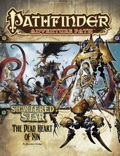
Pathfinder Adventure Path #66: The Dead Heart of Xin (Shattered Star 6 of 6) (PFRPG)Paizo Inc.Add PDF $19.99 Print Edition Unavailable Non-Mint Unavailable Good conclusion, but constrained by the AP's limitsRead my full review on my blog. The Dead Heart of Xin does a very good job. It does provide closure and, on top of that, some truly epic moments. Very importantly, it makes the long quest to gather the separate pieces of the titular Shattered Star worth it, and actually provides the PCs with a chance to use the artifact they’ve worked so hard to acquire. I don’t think it’s a perfect adventure. I think the AP’s focus on dungeons holds this adventure back somewhat, significantly limiting the things that could have been done with it. But overall, The Dead Heart of Xin is a good high-level adventure. And, like the other adventures in Shattered Star, it will work quite well as a stand-alone as well. Read my full review on my blog. Random Urban Encounters is the first product from Raging Swan that I’ve read and based upon it, I’m certainly interested in taking a look at some of their other offerings as well. This is not a book of random encounter tables as its name might imply. Instead, these are just a selection of unrelated encounters that can be used in place of a roll on one of those (let’s face it, rather boring) encounter tables in other books. Each encounter is one or two pages long and contains an overview of the situation, details on the NPCs involved (including background, personality, and distinguishing characteristics, as well as stat blocks), and relevant information about the location. Some of the encounters may not seem the most inspired or creative, but that’s not really a concern. This book accomplishes exactly what it sets out to do: provide gamemasters with quick ready-to-run and easy-to-use encounters. The layout of the book is professional, straight-forward, and easy to read. There is only a limited amount of black-and-white artwork, but this is not something that in any way bothered me. 
Pathfinder Campaign Setting: Irrisen—Land of Eternal Winter (PFRPG)Paizo Inc.
Add
Print Edition
Add PDF $15.99 Non-Mint Unavailable Excellent book!Read my full review on my blog. Irrisen, Land of Eternal Winter is a fabulous book, jam-packed with information that will bring alive any campaign set in the region. Even campaigns set near Irrisen will benefit heavily from the information in this book as the White Witches provide great villains for games set in the Linnorm Kingdoms or the Realm of the Mammoth Lords. It’s full of endless fascinating characters, plots, and locations that I’m dying to use in some future campaign set in and around Irrisen. I highly recommend it. 
Pathfinder Player Companion: People of the North (PFRPG)Paizo Inc.Print Edition Unavailable Add PDF $9.99 Non-Mint Unavailable One of the bestRead my full review on my blog. When Varisia, Birthplace of Legends came out, it set a new bar for quality in the Player Companion line. While the Player Companions that have come out since have been good, they haven’t quite reached that bar again—until now. People of the North once again shows just how good and useful the Companions can be. This book provides everything a player needs to design a character for a campaign set in the far north of the continent of Avistan, particularly in the Lands of the Linnorm Kings, Irrisen, or the Realm of the Mammoth Lords. The book also provides some details for characters from the Crown of the World, including the Erutaki and the Snowcaster Elves. 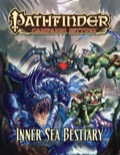
Pathfinder Campaign Setting: Inner Sea Bestiary (PFRPG)Paizo Inc.
Add
Print Edition
Add PDF $15.99 Non-Mint Unavailable Excellent!Read my full review on my blog. The Inner Sea Bestiary is really an excellent book, one that manages to add yet more monsters to the game but still fill a niche for the Golarion setting. The monsters are full of a flavour that can’t quite be achieved in a generic monster book. I know that I’m certainly more likely to use monsters from this book in my own games than many of the monsters from the hardcover bestiaries (such as the zoog, an obscure monster from Bestiary 3 that I just chose randomly). I highly recommend it to all GMs who use the Golarion setting, and even to those who don’t, but still want some new and interesting monsters! 
Pathfinder Campaign Setting: Mystery Monsters RevisitedPaizo Inc.
Add
Print Edition
Add PDF $15.99
Add
Non-Mint
Comprehensive and Useful BookRead my full review on my blog. Mystery Monsters Revisited provides an excellent insight into its ten subject creatures and how they fit into the world of Golarion. It allows gamemasters to enrich their games by including creatures that are more than just nameless things to kill, giving each creature a reason and purpose for being there. And even if some of these creatures never actually show up in a game, the book still provides a compelling read that adds just a little more awe to the game world. 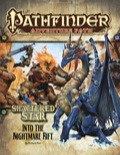
Pathfinder Adventure Path #65: Into the Nightmare Rift (Shattered Star 5 of 6)Paizo Inc.Add PDF $19.99 Print Edition Unavailable Non-Mint Unavailable Competent adventure but not inspiringRead my full review on my blog. I must confess that I haven’t actually read much Lovecraft (my geek cred just went way down, I suppose). However, I have learned about many of the concepts through other sources and I find them endlessly fascinating. So it’s perhaps a bit strange that Into the Nightmare Rift doesn’t quite do it for me. It’s a competent dungeon crawl, but therein lies some of the problem, I think. A dungeon crawl doesn’t feel the right style to do such a nightmarish reality justice. Going from room to room, killing monster after monster (which is what a great deal of this adventure is) doesn’t really allow for a building of dread and suspense, which I feel is really needed (especially for something with the word nightmare in the title). That said, I should stress that I don’t consider this a bad adventure. My problems with it mostly come down to personal taste. In this respect, it’s similar to Shards of Sin, the first part of Shattered Star, in that it’s a competent, well-designed dungeon that just doesn’t grab my attention all that much. Nonetheless, it’s an adventure that probably many people are going to love because it will grab their attention. 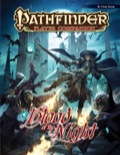
Pathfinder Player Companion: Blood of the Night (PFRPG)Paizo Inc.
Add
Print Edition
Add PDF $9.99 Non-Mint Unavailable Decent book but tries to do too muchRead my full review on my blog. Overall, Blood of the Night is a bit of a mixed bag. It tries to please three similar, but still different, groups in the space of only 32 pages, and as a result, comes out a little lacking. That’s not to say it’s a bad book; it’s a pretty good book, all things considered. It’s just that some people may not find it quite to their expectations. People looking to play vampires may be put off by the space devoted to roles and feats for vampire hunters. People looking to play vampire hunters might find the information on the different kinds of vampires invaluable, but be put off by the space dedicated to dhampir heritages. And while the description of the book on the back cover (and on Paizo’s website) is not misleading, the book shares a naming pattern with Blood of Fiends and Blood of Angels. Those books both deal exclusively with the progeny of their respective titular creatures. As such, there may be people misled into believing Blood of the Night is exclusively about dhampirs. 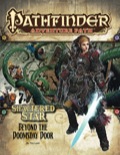
Pathfinder Adventure Path #64: Beyond the Doomsday Door (Shattered Star 4 of 6)Paizo Inc.Add PDF $19.99
Add
Print Edition
Non-Mint Unavailable Excellent AdventureRead my full review on my blog. The fourth instalment of Shattered Star, Beyond the Doomsday Door by Tito Leati, is an excellent adventure. It’s not perfect—there are some confusing inconsistencies in its setting’s history, for example, and it does start to feel a little drawn out by the end—but it contains a fascinating, dynamic setting, and a truly unique villain. It’s a dungeon crawl where you might not want to kill everything you meet along the way, and that’s the kind of thing I love. 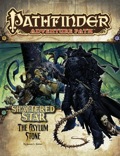
Pathfinder Adventure Path #63: The Asylum Stone (Shattered Star 3 of 6)Paizo Inc.Add PDF $19.99
Add
Print Edition
Non-Mint Unavailable Disappointing adventure, but good support articlesRead my full review on my blog. Unfortunately, The Asylum Stone just doesn’t live up to the possibilities, primarily because it tries to present too many possibilities all in one go. Just as Kaer Maga itself is a hodgepodge of numerous races and organizations, the adventure is like a hodgepodge of disconnected set-pieces with only the thinnest thread linking them together. But while the city of Kaer Maga brilliantly ties all its disparate parts together into one working whole, The Asylum Stone unfortunately doesn’t. There’s simply too much in Kaer Maga to include in one adventure, especially one where the PCs are just passing through. What would work much better is to focus on one aspect of Kaer Maga (much like The Godsmouth Heresy does) with only hints of the rest. What we get instead is an adventure which takes the PCs from one Kaer Magan “gang” to the next with little to no opportunity to interact with each one, only to throw the PCs up against one of the setting’s major villains at the end without ever developing the threat of that villain or its impact on the setting. The adventure ends up feeling like a succession of random encounters and completely loses the magic of Kaer Maga. 
Pathfinder Roleplaying Game: NPC Codex (OGL)Paizo Inc.
Add
Print Edition
Add PDF $19.99 Non-Mint Unavailable Long overdue bookRead my full review on my blog. The NPC Codex is a book I wish had existed years ago. It’s long overdue, but at least it’s here now. It has a stunning variety of character options, with something to meet almost any need. Its presence will cut down the long preparation hours needed to create NPCs considerably. I highly recommend it to all Pathfinder GMs out there. 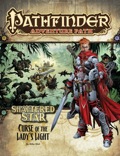
Pathfinder Adventure Path #62: Curse of the Lady's Light (Shattered Star 2 of 6) (PFRPG)Paizo Inc.Add PDF $19.99 Print Edition Unavailable Non-Mint Unavailable Dungeon Crawl Done RightRead my full review on my blog. In Curse of the Lady’s Light by Mike Shel, the second instalment of the Shattered Star Adventure Path, the player characters set out to find the next piece of the titular Shattered Star, the Shard of Lust. This quest takes them to the Lady’s Light, an ancient monument to Sorshen, the Runelord of Lust. Like Shards of Sin before it and the rest of the adventure path still to come, it is primarily a dungeon-based adventure. As I mentioned in my review of Shards of Sin, I can be somewhat critical of dungeon crawls. However, when they’re good, I give them the praise they deserve. Curse of the Lady’s Light is definitely one of those good dungeon crawls. While the actual dungeon itself is somewhat linear, the events that can occur within are surprisingly non-linear, with a wide variety of options for how things might progress. Most importantly, it has a selection of interesting and compelling NPCs. In fact, its two principal villains are amongst the best villains I’ve seen in an adventure path instalment: one sympathetic and tragic, the other irredeemably evil yet uniquely insane. This adventure is definitely a step up from the competent, but not-particularly-awe-inspiring Shards of Sin and could prove a good sign for the rest of the adventure path to come. 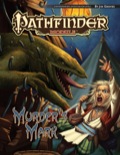
Pathfinder Module: Murder's Mark (PFRPG)Paizo Inc.Add PDF $19.99 Print Edition Unavailable Non-Mint Unavailable Great adventure but with one potentially big problemRead my full review on my blog. I’ve always liked adventures that do something a little different, ones that provide adventuring parties with something that transcends or even ignores the typical tropes associated with Dungeons and Dragons-style games. A well-made dungeon can be fun sometimes, but adventures that actually involve characters with the setting and don’t even go near a dungeon (or ruined castle or ancient caves or whatever large, indoor establishment you can come up with) are often better (assuming they’re well-designed, too). Murder’s Mark by Jim Groves is such an adventure. It’s a charming, low-level adventure centred around a Varisian circus and a murder mystery. It contains a wide assortment of well-detailed and interesting NPCs, each with their own motivations and goals, and lots of opportunity for roleplaying and setting immersion. There are surprisingly few fights in this adventure; however, there are numerous other things to keep the party’s attention and to keep them searching for the answers to the mystery. Alas, the adventure does has one significant problem that could completely ruin things if you have any rules lawyers in your group. However, if you have a group that is simply willing to go with the flow and not worry about a niggling rules detail, Murder’s Mark could make a great adventure to start a new campaign with. 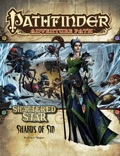
Pathfinder Adventure Path #61: Shards of Sin (Shattered Star 1 of 6) (PFRPG)Paizo Inc.Add PDF $19.99 Print Edition Unavailable Non-Mint Unavailable Competent but not particularly interestingRead my full review on my blog. I have to say that I’m not a big fan of dungeon crawls; however, I do acknowledge that a well-made dungeon can be a lot of fun, and I’ve certainly played through some dungeon crawls that have been very memorable and exciting. The problem with dungeon crawls is that if they’re not done well, they can become a terrible slog that just seems to go on and on. Shards of Sin presents a good, competent dungeon. There’s potential for roleplay and dynamic interaction. There’s a good cast of characters with motivations that help to make sure the adventure doesn’t just become one of going from room to room, killing monsters, taking their stuff, and moving on to the next room. Although the dungeon feels a bit disjointed at times, the problem with Shards of Sin isn’t with its dungeon; it’s that there’s not a whole lot to really grab your attention and hold on to it. Of course, this moves into the territory of personal opinion, so no doubt there will be those who disagree, but I find little in the adventure that really stands out and makes it unique. It’s a bog-standard adventure that is little different from the hundreds of other bog-standard adventures out there. As I said, it’s competently written and I have no doubt it would be fun to play, but it’s the sort of adventure that’s likely to sit on the shelf for a long time while all the other more interesting things get run first. 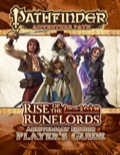
Pathfinder Adventure Path: Rise of the Runelords Anniversary Edition Player's Guide (PFRPG) PDFPaizo Inc.Our Price: FREE Add to CartUseful campaign traits, but otherwise lackingRead my full review on my blog. Overall, the various player’s guides for the different adventure paths make up one area where Paizo still seems to be figuring out what works, given the vastly varying levels of usefulness from one to the next. Unfortunately, the Rise of the Runelords Anniversary Edition Player’s Guide is one of the less successful. Apart from some campaign traits to choose from during character creation, players will get very little use out of this book. 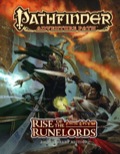
Pathfinder Adventure Path: Rise of the Runelords Anniversary Edition (PFRPG)Paizo Inc.Hardcover Unavailable Add PDF $41.99 Non-Mint Unavailable A great adventure path made even greaterRead my full review on my blog. To start off with, I have to say that this is an absolutely gorgeous book. I mean that both in terms of its physical appearance and its contents. Every page is like a work of art, from the background colouring which gives it a parchment-like look to the sihedron star underlaid with each page number. The top right corner of every right-hand page contains a tab indicating which section of the book you’re in while the left margin of every left-hand page contains identifying artwork from the original cover of the particular instalment. If there’s any problem with the layout, it’s that it looks so good that it makes you want to flip through the book to just look at it and ignore the writing! Of particular note are the maps. While they’re mostly the same maps as before, they’ve been relabelled and are much clearer as a result. I particularly like that stairs now indicate which way is up and which is down. Most of the time, this is pretty obvious, but there have been times in the past when I’ve been unsure which way stairs are going in some Paizo maps. It’s good that it’s clear just in case of any doubt. Also, full stat blocks and abbreviated stat blocks have a new way of showing XP, CR, and HP. It’s a small change, but it makes them stand out just a little more, thus making them just a little clearer. However, as I said, there’s more that’s beautiful about this book than just its layout. A lot of work clearly went into it and it shows. 
Pathfinder Adventure Path #54: The Empty Throne (Jade Regent 6 of 6) (PFRPG)Paizo Inc.Add PDF $19.99 Print Edition Unavailable Non-Mint Unavailable Good and satisfying endingRead my full review on my blog. In Jade Regent, the PCs have set out from their home in Sandpoint, a small town in southern Varisia, trekked north with their caravan to Kalsgard in the Linnorm Kingdoms, then ventured across the frozen Crown of the World to the continent of Tian Xia, crossed through the Forest of Spirits, and arrived in Minkai, the homeland of Ameiko Kaijitsu’s family. Now, having gathered allies, they must set out for the capital city, Kasai, to overthrow the Jade Regent and place Ameiko, the rightful heir, on the throne, in The Empty Throne, the sixth and final instalment of the Jade Regent Adventure Path. Written by Neil Spicer, the adventure has the unenviable task of wrapping up an entire campaign with a suitably epic conclusion, whilst simultaneously allowing for the possibility of more should individual gaming groups wish to continue with their characters. Overall, it manages this pretty well, especially given the difficulties high-level adventures can present to designers. Gaming groups who have played through the entire adventure path will likely find this conclusion exciting, thrilling, and most importantly, satisfying. While the adventure isn’t perfect, few things are, and players aren’t likely to notice its imperfections, especially in the hands of a skilled GM. 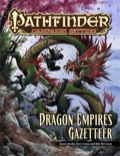
Pathfinder Campaign Setting: Dragon Empires Gazetteer (PFRPG)Paizo Inc.
Add
Print Edition
Add PDF $15.99 Non-Mint Unavailable Great introduction to the settingRead my full review on my blog. The Dragon Empires Gazetteer is an introduction to the continent of Tian Xia, a wonderfully flavourful setting. All the time while reading it, I was constantly getting ideas for new adventures and campaigns I could run in each area. (Alas, too many ideas and too little time to use any of them.) This is the biggest mark in the book’s favour. Any setting book that generates so many ideas has done its job admirably. Another thing I like about the setting is that it takes its influences from more than just Japan and China, but also from Korea, Vietnam, Indonesia, Tibet, and numerous other Asian countries. All blend together to make a varied and vibrant setting with endless opportunity for adventure. 
Pathfinder Player Companion: Dragon Empires Primer (PFRPG)Paizo Inc.Print Edition Unavailable Add PDF $9.99 Non-Mint Unavailable Good introduction to a fascinating settingRead my full review on my blog. Dragon Empires Primer presents a broad overview of the setting from a player perspective. As it serves the same basic purpose as the Inner Sea Primer (which provides an overview of the Inner Sea region), it shares the same style of layout and structure as that book, with half-page entries on each of the nations and main regions, along with new races, archetypes and feats, brief descriptions of the setting’s gods, and a system for keeping track of characters’ honour. Each nation’s entry also includes a pair of regional traits for characters from that land. It’s important to point out, however, that people expecting in-depth detail won’t find it here. Half a page is not a lot of space to describe an entire nation with anything more than the broadest strokes. What the book does do is provide an introduction to the setting, one to whet the appetites of players, and it does this very well. It provides just enough information to get players thinking about the types of characters they might like to play in the setting, and sets the stage for later, more in-depth development, provided by either the GM or future supplements. 
Pathfinder Adventure Path #53: Tide of Honor (Jade Regent 5 of 6) (PFRPG)Paizo Inc.Add PDF $19.99 Print Edition Unavailable Non-Mint Unavailable Great adventure with lots of roleplayYou can read my full-length review on my blog. In Tide of Honor by Tito Leati, the fifth instalment of the Jade Regent Adventure Path, the PCs finally arrive in Minkai, the country of their destination. There they need to begin gathering allies to help them overthrow the Jade Regent and place the rightful heir, Ameiko, on the Jade Throne. Tide of Honor is something of a change in style for the adventure path. What has been primarily a journey from one point to another now starts to set up a home base. Instead of fighting clearly defined enemies blocking their way, the PCs must now engage in a significant amount of diplomacy to win the trust and assistance of people who might be willing to help them, or might not. There are still obvious enemies to fight, but there are also a number of people who could go either way or just remain neutral. There’s a great deal of roleplaying potential in the adventure, more so than any of the previous instalments (with the possible exception of Night of Frozen Shadows), and for groups who prefer that sort of thing, I think this adventure has the potential to be one of the most enjoyable and memorable of the entire adventure path. However, for groups who prefer a more combat-oriented approach, there’s still lots to keep them happy, and GMs can easily gloss over the diplomacy stuff in such cases. 
Pathfinder Campaign Setting: Artifacts & Legends (PFRPG)Paizo Inc.Print Edition Unavailable Add PDF $15.99 Non-Mint Unavailable Great, flavorful resourceRead my full review on my blog. Artifacts & Legends is not the kind of book all GMs will have a use for. After all, some GMs prefer low-powered campaigns and do not wish to deal with the implications of having artifacts in the hands of player characters. However, those who do want to include artifacts in their games or simply wish to include stories of artifacts will find a lot of use for it. It will provide them with the tools to create epic storylines that their players will talk about for many years to come. 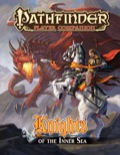
Pathfinder Player Companion: Knights of the Inner Sea (PFRPG)Paizo Inc.
Add
Print Edition
Add PDF $9.99 Non-Mint Unavailable Good overview with lots of character potentialRead my full review on my blog. Knights of the Inner Sea provides players with an overview of what they need to create characters who either are, or are destined to become, knights. It contains information on the most prominent knightly orders in the Inner Sea region of Golarion, their mandates and backgrounds, along with character roles, traits, new magic items, and even a few new spells. It’s important to be aware that, if players are looking for an in-depth treatise about a specific knightly order (including detailed hierarchical structures, lists of prominent commanders and other characters, lists of outpost locations, etc.), they won’t find it here. However, what they will find in Knights of the Inner Sea is a plethora of starting points from which to develop interesting character ideas, along with options for developing those characters throughout their careers (with things such as the new Squire feat). In this manner, Knights of the Inner Sea is a successful and extremely useful book for anyone who wants to create a knight from the Inner Sea region. 
Pathfinder Adventure Path #52: Forest of Spirits (Jade Regent 4 of 6)Paizo Inc.Add PDF $19.99 Print Edition Unavailable Non-Mint Unavailable Fun and EntertainingRead my full-length review on my blog. The fourth volume of the Jade Regent Adventure Path, Forest of Spirits brings the player characters onto the continent of Tian Xia, and ever closer to their final destination of Minkai. But naturally, there are delays and obstructions that they must deal with along the way. Overall, Forest of Spirits looks to be a fun adventure, with moments of light-heartedness early on, followed by an opportunity for the PCs to make their first major strike against the central villains of the entire adventure path. Like the previous instalment, The Hungry Storm, it is very much a travel-from-point-A-to-point-B adventure, but unlike The Hungry Storm, it handles it in such a way as to give a greater sense of purpose to the PCs’ actions by tying it much more thematically to the land in which it’s set and by providing the PCs with a greater sense of accomplishment and resolution. 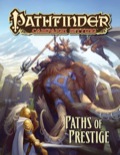
Pathfinder Campaign Setting: Paths of PrestigePaizo Inc.Print Edition Unavailable Add PDF $15.99 Non-Mint Unavailable Good and useful bookRead my full review on my blog. If this book had come out during the time of 3.5, I probably would have groaned and ignored it. Over the years, I have had very few players ever take a prestige class (I’m pretty sure I could count the total number on one hand), and so this just would have been more bloat that would probably never get used. However, with recent emphasis being away from prestige classes, my reaction to this was one of interest. The scattered prestige classes that have appeared in other Golarion sources have all been very flavourful, so there was every reason to believe Paizo could keep it up with a book full of them. To be honest, most of the classes in this book will still likely never see use in any of my games; however, I would consider it very likely that some will get used, if only for NPCs. With only a couple of exceptions (that seem strangely generic), all the classes are extremely flavourful and help to add more options and life to the world of Golarion. 
Pathfinder Adventure Path #51: The Hungry Storm (Jade Regent 3 of 6) (PFRPG)Paizo Inc.Add PDF $19.99
Add
Print Edition
Non-Mint Unavailable Not terrible, but weakYou can read my full-length review on my blog. In every adventure path, there always seems to be at least one volume that doesn’t live up to the quality of the others. For Jade Regent, that volume is The Hungry Storm. It’s a shame because this was one I was particularly looking forward to (I’ve always liked adventures set in the far north and I was particularly eager to see its treatment of the Erutaki, Golarion’s version of the Inuit). There are a lot of good ideas in it, and it’s the first one so far to make heavy use of the caravan, around which the adventure path is supposed to centre. However, those ideas are either not given enough depth or they just don’t string together well. The Hungry Storm is not a bad adventure—I’ve certainly seen far worse ones out there—but it’s not particularly great either. It’s somewhat mediocre overall, and when compared with the two excellent opening volumes, mediocre really stands out. That said, I do believe that in the hands of a competent GM, this adventure can still be a lot of fun for the players, who may not even notice its shortcomings.
Organized Play Characters
Aliases
|
Sign in to create or edit a product review.
Organized Play Characters
Aliases
|




 Lamashan Dalastonor
Lamashan Dalastonor
 D1-UC-B4U
D1-UC-B4U
 Stoat von Bordell
Stoat von Bordell
 Hurlin Beefbone
Hurlin Beefbone
 D1ucb4U'25
D1ucb4U'25